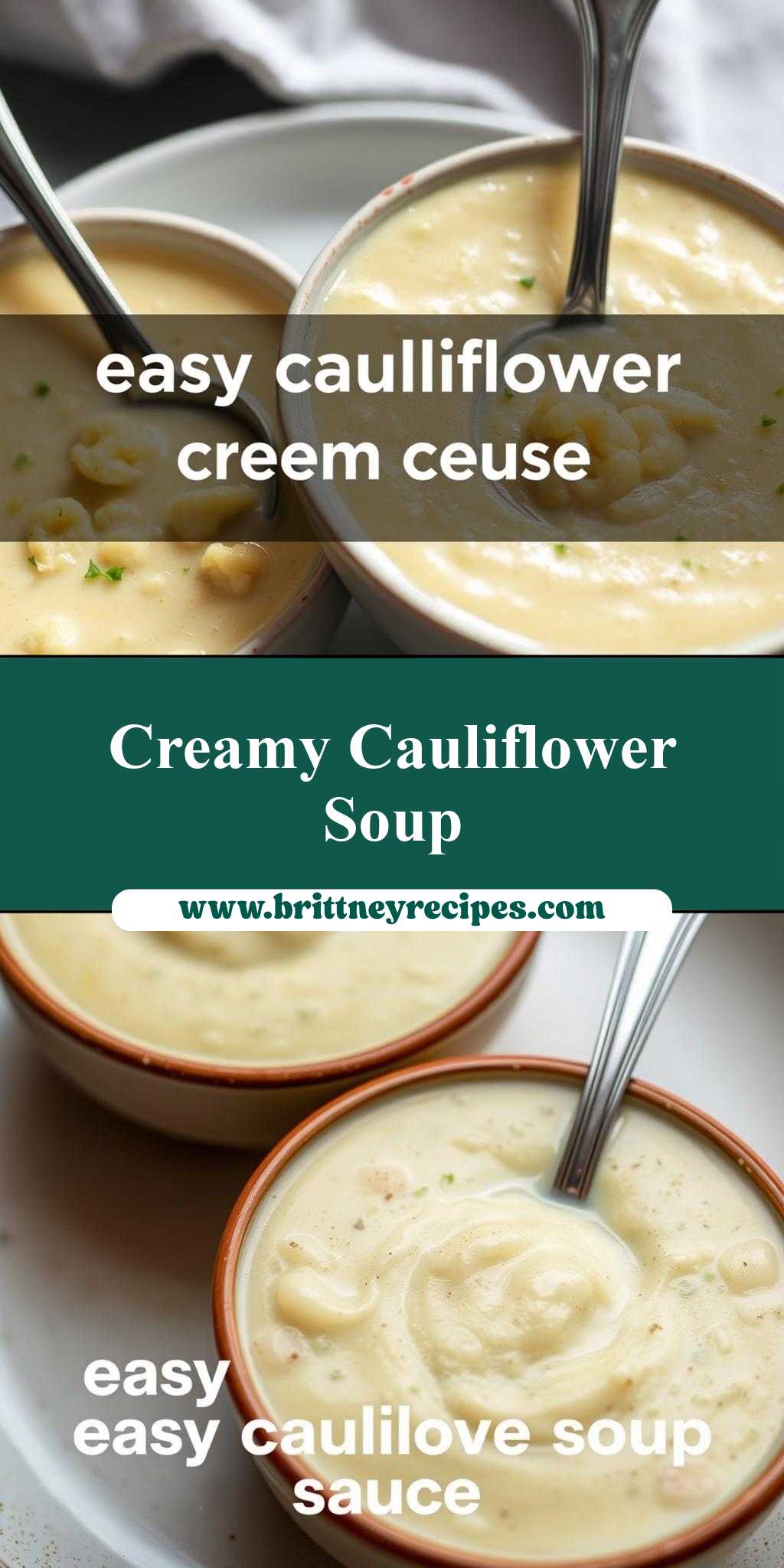What makes a comforting bowl of soup so satisfying? This easy cauliflower cream sauce recipe is made with roasted cauliflower and a hint of garlic, perfect for a quick weeknight dinner. Save this idea for a homemade family favorite to enjoy on a chilly evening.
two bowls of easy cauliflower cream soup with spoons in them and the text overlay says easy cauliflower cream sauce recipe
Introduction
Creamy, comforting, and incredibly easy to make, this cauliflower cream sauce recipe is a game-changer for anyone looking to elevate their meals with minimal fuss. Using everyday ingredients, this dish not only delights the palate with its rich flavor but also showcases the versatility of cauliflower, transforming it into a decadent sauce. Whether you’re a culinary novice or an experienced chef, this recipe promises to deliver impressive results with minimal effort, making it perfect for busy weeknights or special occasions alike.
Why This Works
- Flavor balance and ingredient accessibility: The combination of cauliflower, garlic, and cream creates a balanced flavor profile that is both comforting and sophisticated, using ingredients that are readily available in most supermarkets.
- Ease of preparation: This recipe simplifies the process of making a creamy sauce by utilizing a blender, eliminating the need for tedious stirring or complicated cooking techniques.
- Impressive results with minimal effort: Despite its simplicity, the end result is a dish that looks and tastes like it was prepared in a professional kitchen, making it ideal for entertaining guests or treating yourself to a gourmet meal at home.
Key Ingredients
The foundation of this easy cauliflower cream sauce recipe lies in its carefully selected ingredients. Cauliflower serves as the base, providing a light and healthy alternative to traditional cream sauces. Garlic adds a depth of flavor, while onion contributes a hint of sweetness. Chicken or vegetable broth enhances the sauce’s richness, and heavy cream or a non-dairy alternative adds the desired creaminess. Practical substitutions can be made for dietary restrictions, such as using gluten-free broth or vegan cream alternatives, ensuring this recipe is accessible to a wide range of dietary needs.
Instructions
- Step 1: Begin by prepping your ingredients. Rinse the cauliflower florets, chop the onion, and mince the garlic. Measure out the broth and cream according to the recipe.
- Step 2: In a large pot, sauté the chopped onion and minced garlic in a bit of olive oil until they are softened and fragrant. Then, add the cauliflower florets and enough broth to cover them. Bring the mixture to a boil, then reduce the heat and let it simmer until the cauliflower is tender.
- Step 3: Using a blender or food processor, puree the cooked cauliflower mixture until smooth. Return the puree to the pot, add the heavy cream or non-dairy alternative, and stir over low heat until the sauce is heated through and reaches your desired consistency.
- Step 4: Season the sauce with salt, pepper, and any additional herbs or spices you prefer. Serve hot over pasta, as a dipping sauce, or as a side dish, garnished with fresh herbs or a sprinkle of parmesan cheese for added flair.
Handy Tips
- For a lighter version, you can reduce the amount of cream used or substitute it with a mixture of milk and flour to achieve the desired thickness without adding extra calories.
- Avoid over-blending the cauliflower, as it can become too thin and lose its creamy texture. Blend in batches if necessary, to ensure you maintain control over the consistency.
- Experiment with different spices and herbs to give your cauliflower cream sauce a unique twist. Nutmeg, paprika, or dried basil can add interesting depth to the dish.
Heat Control
When heating the sauce, it’s crucial to do so over low heat to prevent the cream from separating or the sauce from becoming too thick. Stir occasionally to ensure even heating, and remove from heat as soon as the sauce reaches your desired temperature. For reheating leftovers, warm the sauce gently over low heat, whisking constantly to maintain its smooth texture.
Crunch Factor
To add a satisfying crunch to your dish, consider topping the cauliflower cream sauce with toasted nuts, crispy bacon bits, or a sprinkle of crunchy breadcrumbs. These elements not only provide textural contrast but also enhance the visual appeal of the dish, making it more inviting and appetizing.
Pro Kitchen Tricks
- For an extra creamy sauce, add a tablespoon or two of grated parmesan cheese. The fat in the cheese will enrich the sauce, while its umami flavor will deepen the overall taste of the dish.
- Use leftover roasted vegetables, such as carrots or Brussels sprouts, and blend them into the sauce for added flavor and nutrition. This trick also helps reduce food waste and makes the dish more economical.
- Prepare the sauce ahead of time and store it in an airtight container in the fridge for up to a day. Reheat gently when needed, adjusting the seasoning as necessary.
Storage Tips
- Leftover cauliflower cream sauce can be stored in the refrigerator for up to 3 days. Reheat it gently over low heat, whisking constantly to restore its creamy texture.
- When storing, it’s best to use glass or plastic containers that are airtight to prevent the sauce from absorbing odors from other foods in the fridge or freezer.
Gift Packaging Ideas
If you’re considering gifting this cauliflower cream sauce, packaging it in decorative jars with a ribbon and a gift tag can make for a thoughtful and unique present. Include a card with serving suggestions or recipe ideas to inspire the recipient to get creative with the sauce. For a more rustic approach, fill mason jars, secure them with a lid and ring, and wrap with twine or a cloth napkin for a charming, homemade look.
Flavor Variations
- Different spices: Experiment with various spice blends, such as Italian seasoning, curry powder, or smoked paprika, to give the sauce a distinct flavor profile.
- Creative toppings: Top the sauce with roasted vegetables, grilled meats, or a dollop of sour cream to add texture and flavor contrast.
- Ingredient swaps: Substitute the cauliflower with other vegetables like broccoli, carrots, or sweet potatoes to create different variations of the cream sauce.
Troubleshooting
- Texture problems: If the sauce becomes too thick, whisk in a bit of warm water or broth. If it’s too thin, simmer it over low heat until it reduces to the desired consistency.
- Ingredient replacements: If you’re missing an ingredient, consider substitutions that offer similar flavors or textures. For example, you can use almond milk instead of heavy cream for a dairy-free option.
- Over/undercooking signs: The cauliflower should be tender when pierced with a fork. If it’s undercooked, it will retain a crunchy texture. Overcooking can make it mushy and unappetizing.
FAQs
- Can I freeze it? Yes, the cauliflower cream sauce can be frozen for up to 3 months. Thaw it overnight in the fridge and reheat gently when needed.
- Is it gluten-free? The basic recipe is gluten-free, but be mindful of the broth and any additional ingredients you might add, as they could contain gluten. Always check the labels of store-bought items.
- Can I double the recipe? Absolutely, this recipe can be easily doubled or tripled to serve larger crowds. Just ensure you have a large enough pot to accommodate the increased volume and adjust the cooking time accordingly.
Conclusion
This easy cauliflower cream sauce recipe is a versatile and delicious addition to any meal, offering a healthy alternative to traditional cream sauces without sacrificing flavor. With its simplicity, accessibility, and the potential for countless variations, it’s a recipe that will quickly become a staple in your kitchen. Feel free to experiment, share, and adapt it to your tastes and dietary needs, and don’t hesitate to reach out with your own creative twists and favorite ways to enjoy this wonderful sauce.

